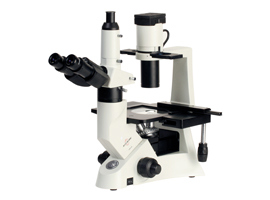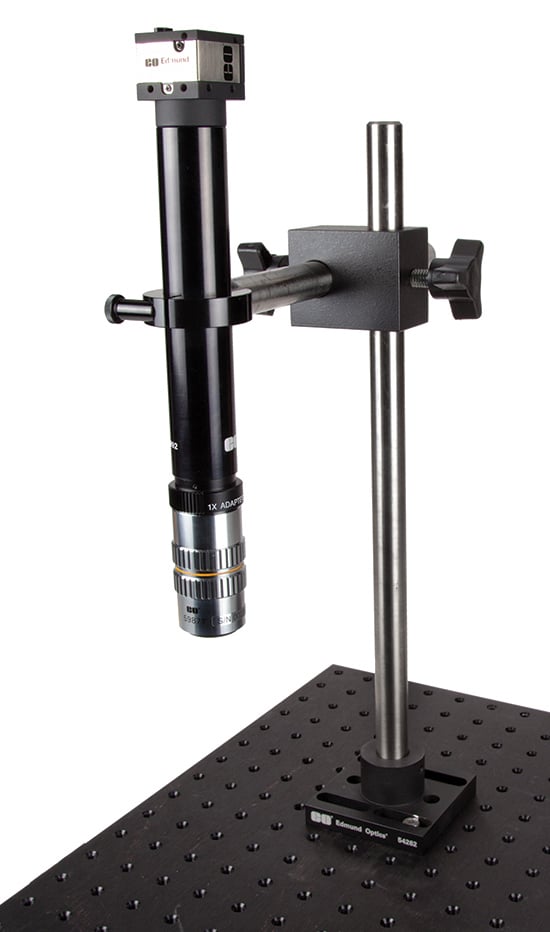Digital Video Microscope Objective Setups
Four-Component System | Seven-Component System

A digital microscope utilizes a camera to record and capture images. A traditional microscope performs visual inspection with an eyepiece, but a digital microscope achieves higher resolution and higher precision than what is typically seen with the human eye. There are numerous applications and setups for these microscopes, ranging from the use of standard DIN and JIS objectives to advanced infinity corrected objectives. Infinity corrected digital microscopes can be quite complex to assemble; however, knowing which components to use and how they work together makes the process accessible for biological, industrial, and any other inspection applications.
To get started, consider the basic differences between finite-conjugate microscope objectives and their infinity corrected counterparts. Finite-conjugate objectives, such as those found in traditional laboratory or university microscopes, focus light directly onto a sensor or eyepiece. Typically, these objectives are achromatic and only correct for chromatic aberration at two wavelengths: red and blue. On the other hand, infinity corrected objectives require an additional optical component, a tube lens, to focus light onto a sensor or eyepiece, but also allow access to the parallel optical plane. By accessing the optical plane, optics for attenuating or filtering light, beamsplitters for in-line illumination, or additional optical components can be incorporated into the setup. Typically, these optics are apochromatic and correct for spherical and chromatic aberration at three wavelengths (blue, yellow, and red), and also have a much higher numerical aperture for improved light levels and contrast. For a more detailed explanation of the different types of objectives, please read Understanding Microscopes and Objectives.
FOUR-COMPONENT DIGITAL MICROSCOPE SYSTEM
When assembling a microscopy system with an infinity corrected objective, there are two setups to incorporate a camera for live video feed and still frame capture. Depending on the simplicity of the setup, one can quickly and easily construct a digital microscope system with magnification as high as 200X. The most straightforward setup involves only four components: a camera, extension tube, tube lens, and microscope objective (Figure 1).

Figure 1: Simple Infinity Corrected Digital Microscope System
The four-component system enables the easy setup of a direct video microscope with high magnification and either high resolution or high frame rate. For example, one can achieve an extremely high resolution image with a pixel count of 3840 x 2748 (10.5MP) at a frame rate of 3 frames per second (fps), or an extremely fast image at 100 fps with a pixel count of 752 x 480 (0.36MP). It is important to remember that no matter the application requirements, the setup remains the same. As a great introductory system, consider using the stock numbers in Figure 2 and listed in Table 1.
| Table 1: Sample Stock No. for Four-Component Digital Microscope System | |
| Stock No. | Description |
|---|---|
| #33-521 | EEO-13122C Color USB 3.0 Camera |
| #56-992 | Mitutoyo to C-mount Camera 152.5mm Extension Tube |
| #54-428 | MT-4 Accessory Tube Lens |
| #59-877 | 10X Edmund Optics M Plan Apo Long Working Distance Infinity Corrected |
The sample components are threaded together and connected, with a full system length just under 267mm (10.5") and optimized for 10X magnification. The digital microscope system length will change slightly depending on the magnification power of the objective in place. A good rule of thumb is: The smaller the objective magnification, the shorter the system length.
Mounting the four-component digital microscope system is as simple as assembling the components. Depending on the object under inspection, the configuration can be mounted in a vertical or horizontal fashion; cellular and biological samples typically require vertical orientation to ensure the sample or fluid does not run. Also, any length post or post holder can be used. As a great introductory system, consider using the stock numbers in Figure 3 and listed in Table 2.

Figure 3: Simple Mounting Configuration for Four-Component Digital Microscope System
| Sample Stock No. for Mounting Four-Component Digital Microscope System | |
| Stock No. | Description |
|---|---|
| #52-930 | C-Mount Ring Mount |
| #39-355 | 90° Angle Mount |
| #52-220 | 3/4" Diameter x 9" Length Horizontal Arm |
| #39-351 | 3/4" Diameter x 12" Length Vertical Post |
| #12-637 | Universal Breadboard Adapter for ¾" Posts |
Other mounting hardware can be used to hold the camera-objective system in place, such as the #85-008 Microscope Objective Nanopositioning System, a piezo driven, flexure guided focusing element system ideal for high precision and high resolution systems. #03-668 Three-Screw Adjustable Ring Mount or #03-669 Bar-Type Lens/ Filter Holder can also be used as simple mounting methods; two mounts are required to ensure maximum stability and grip of the digital microscope system.
With only four primary components, one can create a digital microscope system with magnification as high as 100 – 200X and resolution as low as 300nm. For an explanation on how to take low and high magnification images using an infinity-corrected configuration, please read Understanding Infinity Corrected Objective Resolving Power and Magnification.
SEVEN-COMPONENT DIGITAL MICROSCOPE SYSTEM
Although the four-component infinity corrected digital microscope system is simple, it offers little adaptability. If adding additional optical components into the optical plane is necessary for an application, the seven-component system is the ideal choice. The extra optical elements include additional mounting hardware to accommodate for the 57mm of spacing, which enables the introduction of optical filters, beamsplitters, attenuation, or in-line illumination into the digital microscope. The seven-component system is typically used for fluorescence microscopy or applications that require maximum illumination and contrast. In-line illumination ensures there will be less noise in the system and minimizes glaring and ghosting.

Figure 4: Seven-Component Infinity Corrected Digital Microscope System
The seven-component setup can be a little tricky, but the following explanation aims to make the process as simple as possible. To start, #58-329 MT-1/ MT-2 C-mount Adapter can be opened up and the MT-1 or MT-2 Tube Lenses fit inside. Since the tube lenses themselves have no threads, this adapter provides the necessary C-threads on both sides. Between this adapter and the C-mount camera, an additional 190mm of extension tubes is required. Since the tube lens does not attach directly to the objective, use #55-743 Mitutoyo to C-Mount 10mm Adapter to attach the objective (this adapter adds 10mm of length and adapts the M26 thread to a C-thread). An additional 76.5mm of space between the tube lens and objective is optimal, but it is common to only use about 56.5mm of space between #55-743 and #58-329 since each adapter adds about 10mm of space. With this 56.5mm of space, use extension tubes or add other optical components such as beamsplitters, optical filters, polarizers, etc.
It is important to note that 76.5mm is the recommended distance since these objectives are infinity corrected. However, if the distance is too short, the system may experience vignetting; if the distance is too long, the resultant image will be dim because of insufficient light. To summarize, refer to Figure 4 for an illustration of the seven-component digital microscope system.
Digital microscope systems are powerful optical tools for inspecting industrial and biological samples. They can be as simple or as complex as the user desires, ranging from four-component to seven-component systems. When it is necessary to include optical elements within the optical path of the camera-objective system, the seven-component infinity corrected system is the ideal choice.




























or view regional numbers
QUOTE TOOL
enter stock numbers to begin
Copyright 2023 | Edmund Optics, Ltd Unit 1, Opus Avenue, Nether Poppleton, York, YO26 6BL, UK
California Consumer Privacy Acts (CCPA): Do Not Sell or Share My Personal Information
California Transparency in Supply Chains Act